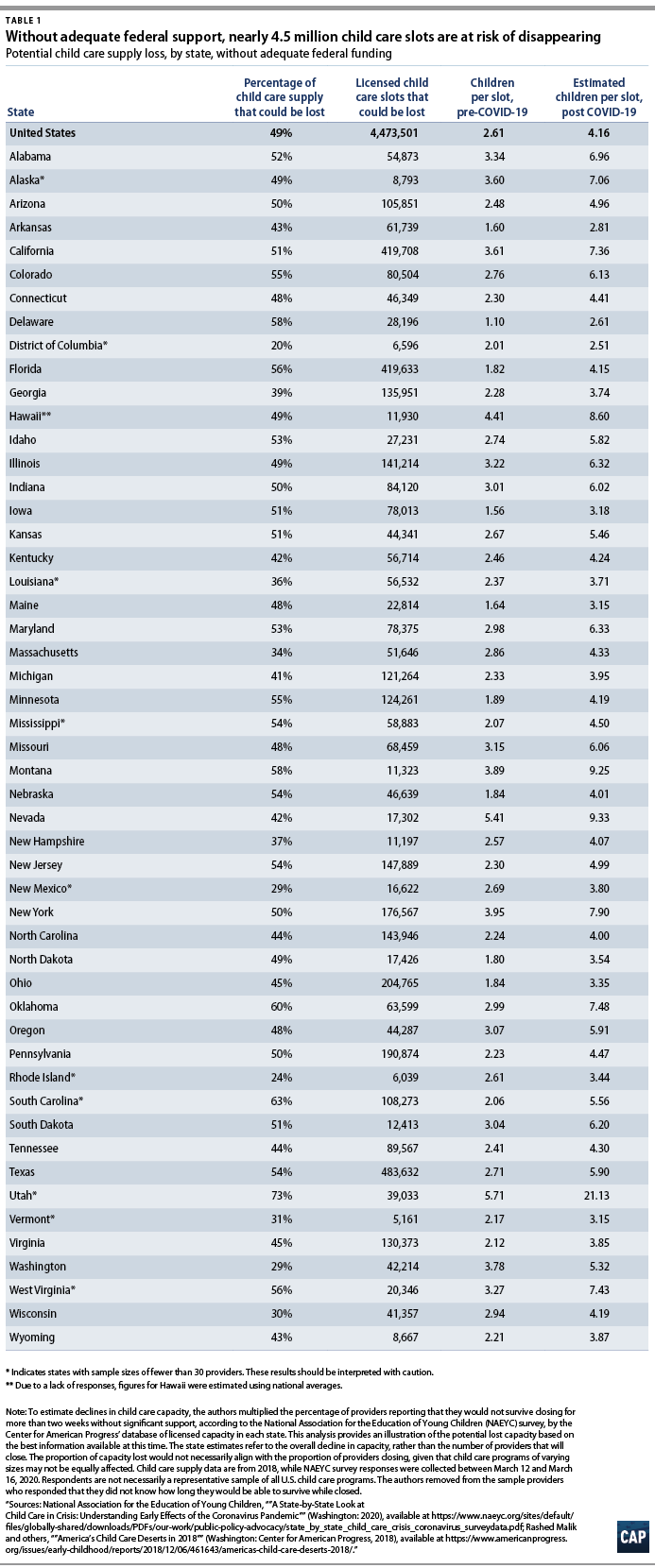The response to the novel coronavirus, which causes the disease COVID-19, has shuttered businesses across the country. Child care providers are no exception. A recent survey from the Bipartisan Policy Center found that 60 percent of licensed providers have already closed and many of those that have remained open have reduced spaces or hours. Troublingly, these closures may not be temporary. A recent survey of child care centers and homes, conducted by the National Association for the Education of Young Children (NAEYC), found that just 11 percent of providers could survive a closure of an indeterminate length of time without government support—and only 27 percent could survive a closure of a month. As physical distancing measures are likely to remain necessary well into the summer, the United States is at risk of losing a large portion of its child care providers, further burdening a system that was already underresourced. To prevent decimation of the child care industry—which enables millions of Americans to work—the federal government must provide immediate resources to child care providers, so that they can pay themselves and/or their employees as well as their rent, mortgage, utilities, and other fixed costs.
To better understand the impact that these potential closures would have on the child care system, this column presents new analysis using state-by-state NAEYC survey response data and Center for American Progress child care deserts data. This analysis estimates that if child care providers do not receive adequate support while they are closed for more than two weeks, roughly half of U.S. child care capacity is at risk of disappearing.

These potential closures add challenges to an existing child care crisis. Even before the coronavirus pandemic, slightly more than half of the country lived in a child care desert—defined as an area where there are more than three children under 5 for each licensed child care slot. Child care providers typically operate on thin margins and struggle to stay in business if they are not consistently collecting tuition and/or subsidy payments for nearly 100 percent of children they enroll.
In the coronavirus relief bill enacted on March 27, Congress allocated $3.5 billion to the Child Care Development Block Grant (CCDBG). This funding is helping states provide crucial temporary aid to providers and support the cost of providing child care for children of essential workers. However, it is not enough to sustain programs throughout weeks of closures. Likewise, while most child care providers are small businesses, few have been able to take advantage of the small business loans offered through the new legislation, and allocated funding has already run out for Small Business Administration loans. Several states have offered emergency funding for child care providers and parents, but these efforts fall short of the full need. States cannot save the child care industry without federal support, as they face additional pandemic-related funding needs and tax revenue declines. Congress must act swiftly by appropriating at least $50 billion for child care.
Child care is essential infrastructure. Without reliable and affordable child care options, millions of parents will not be able to return to work when the pandemic passes. As lawmakers consider the relief needed for child care providers, they should do more than just return the child care system to the inadequate state it was in before the COVID-19 pandemic. Instead, they should build a better future by making a long-term commitment to significant public funding for this critical sector of the economy in order to ensure that all Americans can access the high-quality child care they need.
Steven Jessen-Howard is a research assistant for Early Childhood Policy at the Center for American Progress. Simon Workman is the director of Early Childhood Policy at the Center.
The authors are grateful to the National Association for the Education of Young Children, which conducted the survey of child care providers that made this analysis possible. They would also like to thank Katie Hamm, MK Falgout, Cristina Novoa, Diana Boesch, and CAP’s Art and Editorial teams for their contributions to this column.
To find the latest CAP resources on the coronavirus, visit our coronavirus resource page.